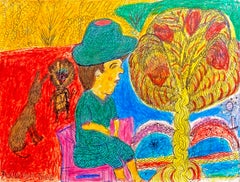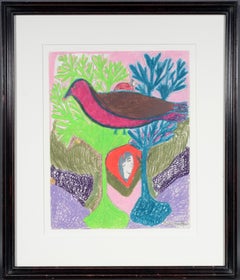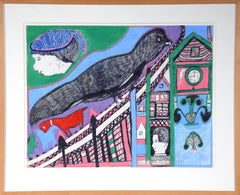Nellie Mae Rowe
20th Century Folk Art Abstract Drawings and Watercolors
Crayon, Pastel, Paper, Graphite
Recent Sales
Late 20th Century Outsider Art Animal Paintings
Paint, Paper, Crayon, Graphite
1980s Outsider Art Figurative Drawings and Watercolors
Paper, Crayon, Ink, Permanent Marker
1970s Outsider Art Animal Drawings and Watercolors
Paper, Crayon, Permanent Marker
1970s Outsider Art Animal Drawings and Watercolors
Paper, Crayon, Graphite
People Also Browsed
Vintage 1970s Italian Mid-Century Modern Sideboards
Glass, Wood
2010s Italian Mid-Century Modern Stools
Aluminum
Vintage 1950s Italian Credenzas
Palisander
Antique Early 1900s American Art Nouveau Table Lamps
Bronze
1950s Animal Prints
Lithograph
21st Century and Contemporary American Modern Credenzas
Chrome
Vintage 1910s American Art Nouveau Table Lamps
Metal
2010s European Bookcases
Walnut
Vintage 1960s American Folk Art Paintings
Plywood, Paint
Antique 17th Century French Aubusson Tapestries
Wool, Silk
Mid-20th Century German Figurative Sculptures
Porcelain
Early 2000s Abstract Impressionist Still-life Drawings and Watercolors
Paper, Watercolor
1970s Drawings and Watercolor Paintings
Oil Pastel, Archival Paper
20th Century American Modern Figurative Sculptures
Marble
21st Century and Contemporary Contemporary Mixed Media
Silver, Stainless Steel
21st Century and Contemporary Realist Landscape Paintings
Oil, Wood Panel
Nellie Mae Rowe for sale on 1stDibs
Finding the Right Drawings-watercolor-paintings for You
Revitalize your interiors — introduce drawings and watercolor paintings to your home to evoke emotions, stir conversation and show off your personality and elevated taste.
Drawing is often considered one of the world’s oldest art forms, with historians pointing to cave art as evidence. In fact, a cave in South Africa, home to Stone Age–era artists, houses artwork that is believed to be around 73,000 years old. It has indeed been argued that cave walls were the canvases for early watercolorists as well as for landscape painters in general, who endeavor to depict and elevate natural scenery through their works of art. The supplies and methods used by artists and illustrators to create drawings and paintings have evolved over the years, and so too have the intentions. Artists can use their drawing and painting talents to observe and capture a moment, to explore or communicate ideas and convey or evoke emotion. No matter if an artist is working in charcoal or in watercolor and has chosen to portray the marvels of the pure human form, to create realistic depictions of animals in their natural habitats or perhaps to forge a new path that references the long history of abstract visual art, adding a drawing or watercolor painting to your living room or dining room that speaks to you will in turn speak to your guests and conjure stimulating energy in your space.
When you introduce a new piece of art into a common area of your home — a figurative painting by Italian watercolorist Mino Maccari or a colorful still life, such as a detailed botanical work by Deborah Eddy — you’re bringing in textures that can add visual weight to your interior design. You’ll also be creating a much-needed focal point that can instantly guide an eye toward a designated space, particularly in a room that sees a lot of foot traffic.
When you’re shopping for new visual art, whether it’s for your apartment or weekend house, remember to choose something that resonates. It doesn’t always need to make you happy, but you should at least enjoy its energy. On 1stDibs, browse a wide-ranging collection of drawings and watercolor paintings and find out how to arrange wall art when you’re ready to hang your new works.


